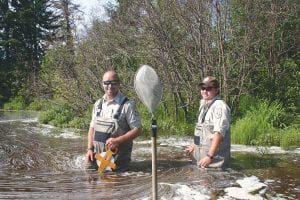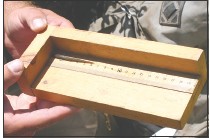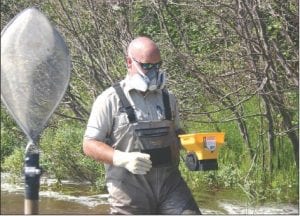When Alex Larson first put his electrofishing paddle into the shallow, creamy coffee-colored estuary of the Brule River on Monday, August 15, no one expected what happened next. The water seemed to explode as a large, angry northern pike woke sharply from its nap, blasted to the surface and torpedoed across the water for about 30 feet before descending back into deeper shockproof depths.
“I wasn’t expecting that,” Larson exclaimed as he and his chief, Nick Rewald, both laughed in surprise.
“That doesn’t happen too often, but it has happened to us before,” Rewald said.
The search for lamprey larvae
The two U.S. Fish and Wildlife Service assessment crew workers were conducting their eighth river survey on a trip that started in Ashland, Wisconsin on Tuesday, August 9. Their only stop in Cook County was the Brule River.
On this picture perfect day, with small boats carrying sport fishermen at the river mouth and the shoreline filled with strolling couples and families, Rewald and Larson spent hours in the warm river conducting chemical tests and electro-shocking to see if they could find sea lamprey larvae.
Most surveys are conducted by electrofishing, but in deep waters crews use chemicals which have proven to be of no “unreasonable risk” to the general population and the environment when applied at concentrations necessary to detect larval sea lampreys.
Rewald said their efforts are the first part of the system to control sea lamprey in the Great Lakes. “As a survey crew we find the lamprey, determine their distribution in a river, then estimate how many there are in that river. An assessment is made and if needed, a treatment crew will be sent to treat the river. He said his crews also trap adults in the spring.
On this trip Rewald and Larson first investigated silt river bottoms where sea lamprey bury and hatch eggs. The juveniles stay in the river from three to five years before moving into the lake where they live for one and a half years longer, growing quite large before coming back to spawn and die.
Once Larson and Rewald found the right silty bottom they measured two small areas of about 100 feet by 500 feet and spread Bayluscide, a yellow chemical that settles to the bottom and deprives the lamprey of oxygen. During this task the men wear respirators, protective clothing, long waders and gloves.
After waiting 10-15 minutes to see if the chemical had worked, they searched, catching one lamprey after about an hour.
When the chemical works the affected lamprey swim to the surface, often swimming in circles to be scooped up and put in a white plastic bucket.
During the survey, the two men use scaplets—long poles equipped with wire mesh scoops used to scoop up shocked or oxygen starved sea lamprey larvae.
Once on shore the lamprey are measured, weighed and disposed of. If the lamprey happens to be native, they are returned to the river, Rewald said. On this day the sea lamprey measured were from 64 millimeters to 133 millimeters long.
“We are only allowed to use 20 pounds of Bayluscide on a river,” said Rewald. “We only used 10 pounds on these two sections. I think that electro shocking works better than using chemicals to find the larvae, but I guess they both have their places where one works better than the other in some rivers,” he added.
Lamprey larvae found in Brule
The news wasn’t great because at the end of the day they tallied 19, which means the river may have to be treated.
“The last time we checked the Brule River [2014] we got 10 larvae,” Rewald said. “The year before that we caught two and in 2012 we caught 12.”
“We generally check the Arrowhead [Brule] River every other year,” said Shawn Nowicki, larval unit supervisor for the Marquette Biological Station of the U.S. Fish & Wildlife Service. “The last time we treated it with lampricide was 2009.”
Lampricide is a chemical used to kill sea lamprey larvae and is generally applied to a river every three to five years, Nowicki said.
An invasive species, the arrival of sea lamprey into the Great Lakes destroyed a way of life for many. At one time there was a commercial fishhouse every quarter mile from Duluth to Grand Portage. During the 1940s sales of lake trout accounted for an average commercial catch of 7,000 tons per year. The fish were marketed throughout the Midwest and east coast, but in the 1920s fishermen started to lose their catch to a new predator: sea lamprey.
Over the next 40 years the lamprey devastated the fish population in Lake Superior, especially lake trout. Each lamprey eats as much as 40 pounds of fish in its lifetime.
By 1962 the season was closed to netting, and most commercial fishermen pulled their boats from the water and hung their nets to dry for the last time. An era had ended. Today there is only a scattering of commercial fishermen left on the “Big Lake,” but sport fishing has boomed as lake trout and other Lake Superior fish have made a dramatic return thanks to the joint U.S./Canadian program to eradicate sea lamprey.
The sea lamprey control program is operated by the Great Lakes Fishery Commission, in partnership with the U.S. Fish and Wildlife Service, Department of Fisheries and Oceans Canada, U.S. Army Corps of Engineers, and U.S. Geological Survey. The Commission initiated chemical control of sea lampreys in 1958. Since that time the highly successful program has contributed significantly to the maintenance of the $7 billion Great Lakes sport and commercial fisheries.
The Commission is also developing a strategy to increase the number of barriers on sea lamprey-producing streams, and is conducting research into barrier design, traps, attractants, and biological control.
Nowicki said the only other river in Cook County surveyed for sea lamprey is the Pigeon River in Grand Portage. “That’s assessed yearly by Canadian Fisheries and treated more often than the Arrowhead [Brule] River. It is a bigger producer of lamprey larvae.”
As for Rewald and Larson, they were returning to their hotel in Superior, Wisconsin when they finished for the day. Both men love to fish, but not in rivers. “I spend a lot of time wading in rivers, so when I fish I go out in a boat and chase walleyes or trout,” said Rewald. Larson nodded his head in agreement.
As for the lamprey population in Lake Superior, Rewald said, “The programs that we have been working on over the years have done their job. We can’t get all of the lamprey, but we have successfully held their numbers down below our stated goals, so we are pleased with the accumulative efforts of our programs.”
Sea lamprey attach to fish with a suction cup mouth, cut a hole through the fish’s scales and skin, and feed on blood and body fluids. Sea lamprey larvae hatch from eggs laid in gravel nests, and drift into silty river bottoms where they burrow and live for several years. Larvae sometimes drift and settle in the immediate offshore areas near stream mouths. Failure to detect and subsequently eliminate larvae allows the lampreys to transform into parasitic adults that kill Great Lakes fish.





Leave a Reply